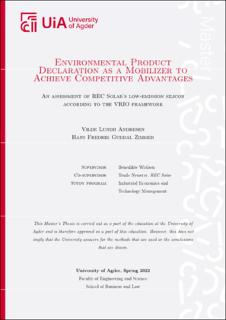| dc.description.abstract | Global climate challenges have led to a significant increase in renewable energy production. Currently, energy generated from the sun is the fastest-growing energy source globally. Solar panels based on silicon make it possible to transform solar energy into electrical energy. However, the extraction of silicon is highly energy-intensive, hence potentially contributing to significant pollutant emissions. On the other hand, a Norwegian silicon producer, REC Solar, has chosen to utilize a more expensive technology, resulting in lower polluting emissions.
Environmental Product Declarations (EPD) are used to document and promote the environmental effects of a specific product developed according to international standards and Life Cycle Analysis. The EPD is founded on Product Category Rules (PCR) to create a basis for comparison regarding environmental properties for products with equal satisfactory qualities. Thus, EPDs can contribute to more sustainable procurement. The harmonization of PCRs and the prevalence of EPDs have been proven to be most significant in the construction industry. Therefore, an empirical study has been conducted within this industry.
The thesis aims to investigate EPD's active role in a competitive market and how it can contribute to REC Solars' utilization of low-emission silicon. A quantitative study has been conducted to retrieve experiences from EPD-owners in the Norwegian construction industry. In addition, a qualitative study has been conducted to analyze how contractors evaluate EPDs in procurement processes. Finally, the empirical results are structured in a theoretical resource management framework to assess the EPD's ability to mobilize low-emission silicon and achieve a lasting competitive advantage.
The research results show that EPD can mobilize low-emission silicon as a resource. However, the perceived value of low-emission silicon is currently not adequate for buyers to prioritize lower emissions above price. The study promotes that an increased number and more explicit incentive systems are needed for the environmental properties of products to have a greater impact on procurement decisions. Hence, appropriate the potential value and achieve lasting competitive advantage. | |
